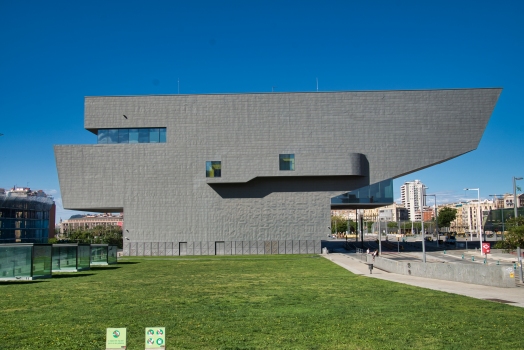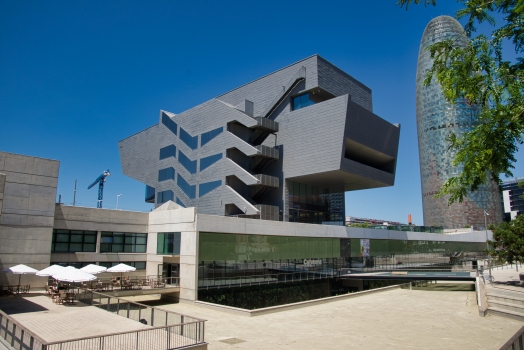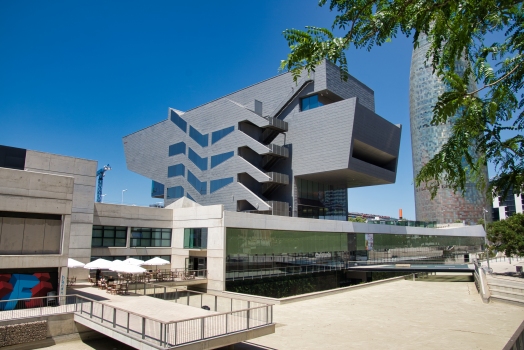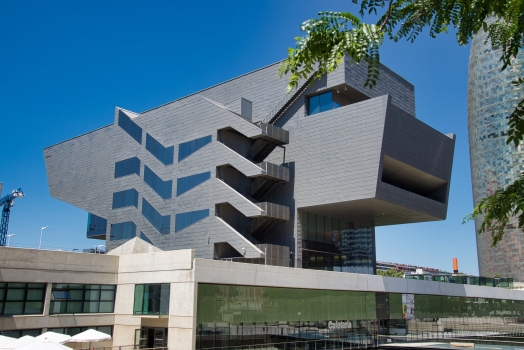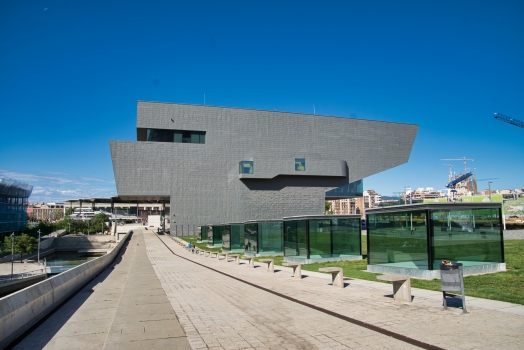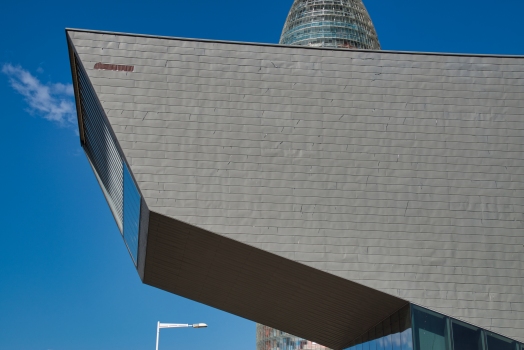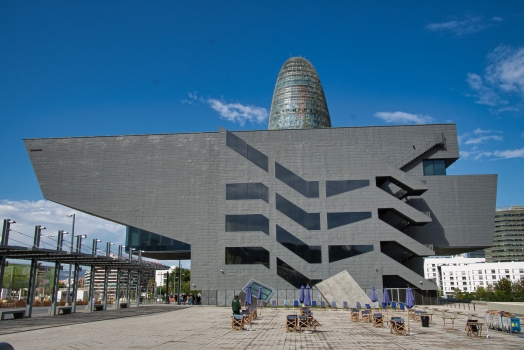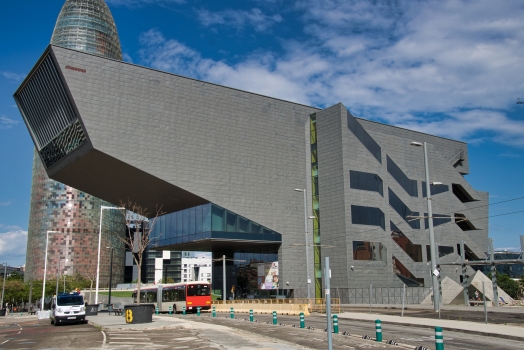General Information
| Name in local language: | Museu del Disseny de Barcelona |
|---|---|
| Other name(s): | Design Museum of Barcelona |
| Completion: | 2014 |
| Status: | in use |
Project Type
| Material: |
Steel structure |
|---|---|
| Structure: |
Horizontal cantilever structure Truss |
| Function / usage: |
Museum building |
Location
Technical Information
Dimensions
| height | 20 m | |
| cantilever length | 35 m |
Materials
| cantilever trusses |
steel
|
|---|
Excerpt from Wikipedia
The Museu del Disseny de Barcelona (Catalan, English: "Barcelona Design Museum"), is a new center of Barcelona's Institute of Culture, which works to promote better understanding and good use of the design world, acting as a museum and laboratory. It focuses on 4 branches or design disciplines: space design, product design, information design and fashion.
The Museum is the result of the merging of several previous existing museums, such as the Museu de les Arts Decoratives, the Museu Tèxtil i d'Indumentària and the Gabinet de les Arts Gràfiques collection. The opening of the new headquarters, located on Plaça de les Glòries, next to Torre Agbar, was set gradually during 2014.
History
Barcelona is a city historically linked to design, with old institutions such as the Foment de les Arts Decoratives. That is why the city of Barcelona was raised earlier in the decade of 2000 to create a single center, an integral space to allow the public to understand design in a broader consideration. It was decided to build a single space in which locate all collections and endowments existing in Barcelona related to the world of design, and Oriol Bohigas commissioned the construction of a building in the Plaça de les Glòries. It was originally going to be named Barcelona Design Museum, then from 2008 to 2013 it was named Design Hub Barcelona, but finally it was renamed again as Museu del Disseny de Barcelona (Design Museum of Barcelona).
Goals
The center is a meeting point of a network of people and institutions involved in the design world, and shares relevant information related to the sector. The aim is to encourage both research and economic activity linked to the world of design, using both own equity funds, as of this ongoing analysis of the design world.
Building
The Barcelona Design Museum is located at the DHUB building in the Plaça de les Glòries. It was designed by MBM architecture firm, formed by Oriol Martorell, Oriol Bohigas and David Mackay. The building construction started in July 2009, when the counselor of Culture Joan Manuel Tresserras and the mayor Jordi Hereu, laid the first stone. Construction ended in 2013, and the Design Museum of Barcelona opened its doors in 2014.
The building consists of two parts: an underground one (using the level change caused by the urbanization of the Glories square) and one that emerges 14.50 meters above the ground. The latter is a parallelepiped bias cut with the same width as the Avila Street, acting as an indicator of the relationship between the Eixample streets and the Glòries square, without affecting the view of the large central park. The cover of the subway is a public space linked to the future project of the Plaça de les Glòries park. The green carpet is one of the important components and it is made with natural or artificial elements to ensure sustainability and easy maintenance.
It includes a bar and restaurant, offering an attractive public space. The lake acts as a compositional emphasis relating the various levels.
Ground Floor
Includes two floors and a mezzanine, denser activities, such as main exhibition hall, reservations, research and teaching, well-attended services, etc. Natural lighting and the relationship with the outside, despite being a basement, is achieved through the pit produced by the difference of levels, reinforced sheet water reflecting a kind of large forecourt. This lighting is reinforced with six skylights that emerge in the public and may be used as showcases for the contents and activities of the Centre.
First Floor
According to planning, it uses the minimum floor area in order not to reduce the space for public use. Cantilever extends into the square, allowing the planned building area. The set of the two bodies that make up the center enters through a single hall with double access: +7 m level., From Avila Street, and at +14.5 m., From the square. This hall is a kind of street or public place, public or semi-almost a must to relate the square of the Glories, the Poblenou and metro and the exchanger. From this square an set of stairs, escalators and elevators reach all the services located in the basement and all the upper floors of various dimensions and characteristics, up to the conference room. The exterior of the building uses only two materials: metal plates (zinc or aluminum) and glass, so that, together, have an industrial look with metallic reflections.
Sustainability
The entire project involves a high degree of environmental quality, sustainability and energy sufficiency. It may indicate the most important chapters: passive sustainability (material and structure of massive facades and finestram, storage and processing, pre-engineered systems, shading and insulation, etc., Within the criteria of Distinctive Guarantee environmental quality of the Generalitat and the EU Ecolabel), sanitation (separative network to reuse rainwater), plumbing (minimum consumption control and regulation of flows, solar collectors for hot water production for a minimum of 70%), air conditioning (water chillers for air condensed high performance, low noise and acoustic protection, heat recovery chiller plants, natural gas boilers, free cooling when outdoor conditions permit, latent heat recovery in the extraction of air), electricity (low power, presence detectors, testers timed, photovoltaic panels for direct use of solar power), centralized management of all facilities.
Museums
The Barcelona Design Museum is the result of merging several previously existing local museums: Museu de les Arts Decoratives (created in 1932), Museu Tèxtil i d'Indumentària, the Gabinet de les Arts Gràfiques, and the Casa Bloc Apartment Museum.
Documentation center
The Museum also hosts a library dedicated to the greater areas in the world of design: product, fashion, information and interior design. The initial bibliographic reserves contains over 9,000 published documents dating from the 16th century to the present day. And 1,600 of those dating from before 1950. The reserve originated in the old libraries of the Museus Tèxtil i d'Indumentària de Barcelona and the Museu d'Arts Decoratives de Barcelona, the Gabinet de les Arts Gràfiques de Barcelona and the BCD (Barcelona Centre de Disseny). These sources have received numerous donations over the years by professionals, individuals, institutions and businesses. Particularly noteworthy for their uniqueness and excellent state of preservation, the bibliographic reserves of the Museu Tèxtil i d'Indumentària are made up largely of two very large donations: the bequest of the Comtesa de Vilardaga and the donation by Sr. Manuel Rocamora. The majority of the bibliographic reserves can be found in the reading room and are accessible to the public. It has developed its own classification system: IMAG.
The most valuable documents, the oldest and those that are referred to the least, can be found in a deposit in the DHUB building. The Documentation center uses RFID technology (Radio Frequency Identification) to keep track of the number of consults each document receives. With this information, the documents that are the most in demand are always located in the reading room for ease of access.
The historic reserves of magazines and journals are still being catalogued. The centre keeps over 100 subscriptions to specialist magazines and journals.
Text imported from Wikipedia article "Design Museum of Barcelona" and modified on July 23, 2019 according to the CC-BY-SA 4.0 International license.
Participants
Relevant Web Sites
Relevant Publications
- (2015): El Centro de Diseño de Barcelona. In: Hormigón y acero, v. 66, n. 275 (1st Quarter 2015), pp. 55-67.
- (2014): The New Barcelona Design Centre. In: Structural Engineering International, v. 24, n. 1 (February 2014), pp. 49-52.
- About this
data sheet - Structure-ID
20075965 - Published on:
27/09/2018 - Last updated on:
05/06/2019

